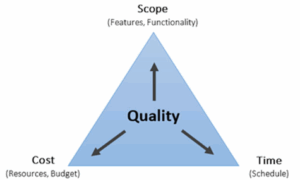Lean construction is a project management approach aimed at making construction projects more efficient, cost-effective, and higher in quality. It focuses on delivering value to the client, eliminating waste, and continuously improving processes. Lean construction relies on detailed planning and rigorous control to ensure projects progress efficiently and within agreed timelines and budgets. The method also promotes close collaboration among all construction stakeholders (client, project manager, architect, design offices, and contractors) to improve project efficiency. Read on to discover how lean construction can support better site management.
Lean Construction: Applying Lean Management Principles to the Construction Sector
Lean management is a productivity-driven methodology that seeks to enhance product or service quality through ongoing process efficiency and simplification. Originating from Toyota’s supply chain management practices in the 1970s, it is based on the “pull” and “push” production principles.
Its primary objective is to eliminate unnecessary costs by removing waste that does not add value to the client. This is achieved by addressing idle time caused by supply delays or poor scheduling coordination.
The method helps avoid technical defects that compromise quality, and by extension, client satisfaction. Lean management improves communication among stakeholders to ensure timely delivery and the required quality. When applied to construction, the goal is to eliminate all forms of waste generated on site, be it lost time or unused materials.
This evolution of lean management has given rise to lean construction, which has grown in the UK since the 1998 Egan Report, which called for greater efficiency and collaboration in the industry. This led to the creation of the Lean Construction Institute UK (LCI-UK), which continues to promote lean principles today. In other words: doing more with less. Labour shortages and volatile material prices have contributed to its adoption in construction.
Key Principles of Lean Construction
The core principles of lean construction include:
- Maximising value for the client
Lean construction focuses on delivering client value. This requires understanding client needs and ensuring the construction project meets them efficiently. - Eliminating waste
A fundamental lean principle is to reduce or eliminate waste across all processes. In construction, this means cutting down on unused materials, minimising delays, and optimising labour usage. - Continuous process improvement
Lean construction promotes a culture of ongoing improvement. This involves constantly assessing construction processes to identify opportunities for enhancement. - Effective planning and controls
Detailed planning and strict control of site processes are crucial to ensure projects stay on track in terms of time and cost. - Teamwork and collaboration
Strong collaboration across all stakeholders, architects, engineers, contractors, suppliers, and operatives, is essential, supported by open and effective communication.
How Can Lean Construction Improve Site Performance?
The UK construction industry faces several key challenges. Projects are becoming more complex, requiring tight coordination of materials, teams, and resources. Labour shortages are also a growing concern: in late 2024, there were approximately 35,000 unfilled construction jobs, up from 26,000 in 2019, highlighting the widening skills gap (TMHCC, 2025).
Tight budgets and delivery deadlines remain constant pressures. For instance, UK construction costs rose by 4.1% in 2023 and are projected to rise a further 3-3.8% in 2024 (Davis Trackhire). These cost hikes, paired with high interest rates and declining public-sector funding, led to over 4,260 insolvencies in the sector in 2024 alone, accounting for 16.2% of all insolvencies in England and Wales (Beach Marketing, 2025).
At the same time, there’s growing awareness around sustainable construction. Developers must increasingly comply with strict environmental regulations, such as the Future Homes Standard (effective from 2025), which introduces more rigorous energy efficiency and carbon emissions requirements (Construction Briefing, 2025).
Further complications include legal disputes and delays: although precise UK-wide figures are scarce, project complexity and evolving regulations are contributing to a rise in contractual disputes, delays, and cost overruns.
The solution? Adopting lean construction principles to:
- Reduce costs and waste (overproduction, waiting times, excess inventory, unnecessary movement, transport, rework, etc.).
- Improve team productivity and efficiency.
- Increase the quality and sustainability of the final product.
What Are the Goals of Lean Construction?
In construction, lean follows an agile, collaborative framework that extends right up to project handover. Its goals align with the benefits available to all stakeholders, project managers, architects, contractors alike:
- Identify and eliminate sources of waste to improve overall performance.
- Optimise storage areas and resources, avoiding overproduction and ensuring product quality throughout the build.
- Reduce costs by increasing team efficiency and avoiding loss. Cutting unnecessary processes and using resources optimally also improves profit margins.
- Involve every link in the value chain to foster collaborative production and streamline operations.
- Enhance communication between project leaders, teams, contractors, and clients.
- Be more responsive and customer-focused through increased agility.
- Deliver high-quality, end-to-end project outcomes.
Ultimately, lean construction delivers continuous process improvement and strives for operational excellence: maximising client value while minimising waste.
How to Implement Lean Construction on Site
Adopting lean construction on site involves a structured approach:
- Identify causes of downtime
Analyse why time is lost on site, due to poor coordination, communication gaps, lack of planning, or failure to anticipate needs. - Embrace continuous improvement
Lean construction is rooted in constant improvement. Challenge existing working methods, simplify them, and reduce waste. - Involve and train staff
Teams must be actively involved in identifying and deploying optimisation strategies. Training is key to successful implementation. - Use suitable digital tools
Leverage construction management platforms to enhance team productivity, workplace safety, and site efficiency. - Plan tasks rigorously
Develop and track detailed schedules that include input from all stakeholders to ensure alignment, prevent delays, and boost overall performance.
Why Tracking Key Performance Indicators (KPIs) Matters
KPIs are vital for lean construction. They help measure, assess, and enhance construction process performance.
KPIs provide insight into how well continuous improvement efforts are working and highlight areas for further development.
Here are the most important KPIs to track:
- Cycle time – Measures the duration to complete a specific task from planning to delivery, helping spot inefficiencies and delays.
- Completion rate – Tracks the percentage of planned tasks finished on time, showing project progress and cumulative delays.
- Quality rate – Assesses work quality against project specs, often measured by the number of snagging issues per trade.
- Safety rate – Tracks site safety incidents (e.g. injuries), guiding corrective actions where necessary.
- Cost – Evaluates project financial performance, including labour, materials, waste (CD&E waste), and equipment spend.
- Client satisfaction – Measures client contentment at project end, based on delivery timeliness and work quality.
Centralising this data in a collaborative project management tool helps identify site phases prone to delays or high snag counts. Once identified, teams can develop targeted strategies to improve site efficiency.
Five Steps to Optimise Lean Construction on Site
- Create a collaborative schedule
Efficient site collaboration requires good communication. Update the shared schedule at every site meeting, with each trade accurately estimating task durations while respecting the sequencing of work. A Gantt-style collaborative tool ensures resource planning and reduces errors. - Streamline resource and logistics management
Materials, labour, equipment, and waste move constantly on site. The HSE officer (or site manager) should define storage zones and traffic routes using a “dynamic site layout plan” to ensure flow, save time (no more hunting for tools), and prevent accidents. - Divide the site into zones
Construction involves sequential tasks. Zoning the site avoids downtime. Instead of waiting for all shell work to finish on one level, break it into zones (A, B, C), allowing finishing trades like plasterers to begin earlier. This helps keep to schedule. - Apply the 5S method
Useful across the site, depot, or offices:- Sort – Remove what’s unnecessary.
- Set in order – Organise items.
- Shine – Keep clean.
- Standardise – Establish and maintain rules.
- Sustain – Audit and improve the system.
- Use the “5 Whys” method
Investigate root causes by asking “why” five times:- Problem: Poor-quality office finish. Why?
- Rushed work. Why?
- Ran out of time. Why?
- Informed too late. Why?
- Poor project planning. Why?
- Lack of project management tools.
The fix? Implement proper planning tools.
NOTE : There are many other lean tools available. We’ve shared the most relevant ones for agile construction project management.
Benefits of Applying Lean Management in Construction
Lean construction helps projects stay on time and on budget. It also encourages a more open and team-based approach on site, where good ideas can come from anyone, not just managers. When teams work together and focus on getting things right the first time, they avoid costly mistakes and delays.
That’s where site productivity apps come in. They support lean principles by giving teams real-time visibility on progress, delays, and bottlenecks. Apps like Site Diary, Site Task, and Site Supervision streamline communication, reduce paperwork, and eliminate duplication of effort.
With the right digital tools, you can:
- Monitor work as it happens and flag issues early.
- Coordinate tasks and deliveries to avoid idle time.
- Track resource use and reduce unnecessary movement.
- Build data-driven dashboards that help drive continuous improvement.
In short, site productivity apps are essential for putting lean construction into practice, turning daily activity into measurable progress.
FAQ: Lean Construction
Why adopt lean construction?
To save time, money, resources, and energy. It’s about improving efficiency with a practical, agile mindset.
How does a company become lean?
Through growing agility step by step, with consistent effort and a Kaizen mindset (Japanese for “continuous improvement”).
How can a lean site help a developer build better?
By applying lean methods, developers can reduce costs and delivery times while enhancing quality and customer satisfaction. Lean also limits risks and non-conformities, crucial for timely handovers. For example, if a worker lacks the right (updated) plan, this leads to wasted time, materials, and budget. Fixing such mistakes causes knock-on delays for following trades.




